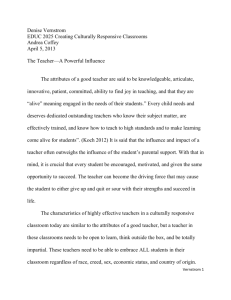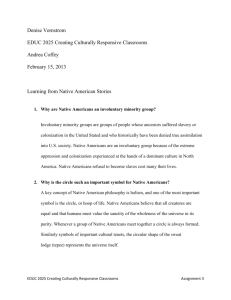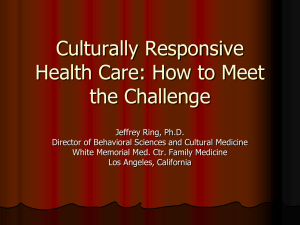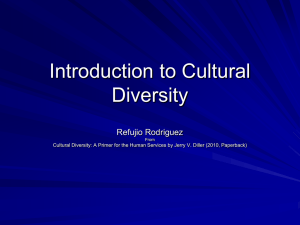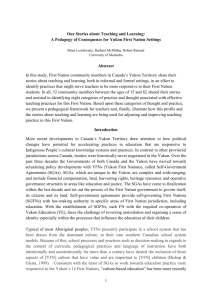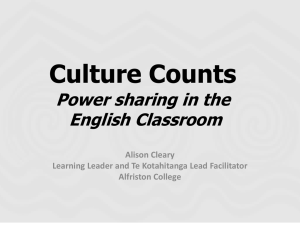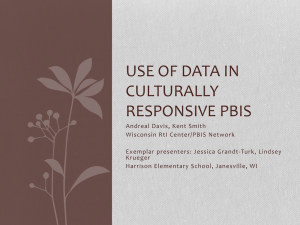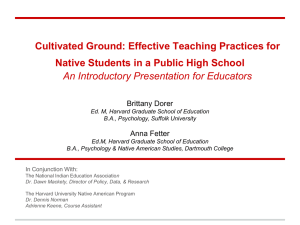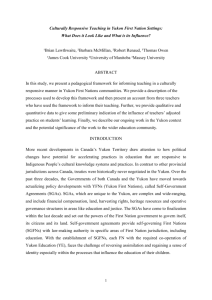ppt - University of Manitoba
advertisement
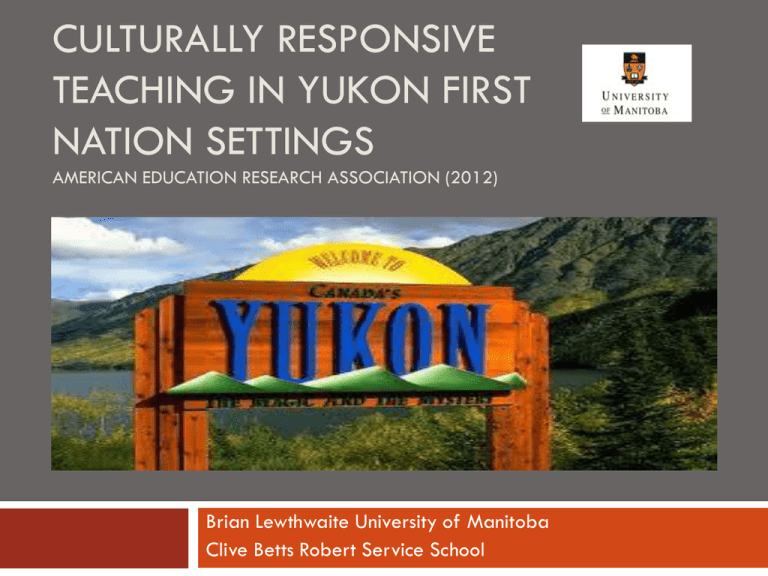
CULTURALLY RESPONSIVE TEACHING IN YUKON FIRST NATION SETTINGS AMERICAN EDUCATION RESEARCH ASSOCIATION (2012) Brian Lewthwaite University of Manitoba Clive Betts Robert Service School Area 482,443 km2 Population 34,000 Whitehorse 22,000 Dawson City 1,200 California 411,048 km2 Current Policy Focus of Yukon Education “Culture-based education”: foundational principle for school development in many of Canada’s northern settings: Yukon and Nunavut, NWT Educational experience provided for children should reflect, validate and promote the culture, processes and language of the community it represents In a culture-based education program the content, skills, processes, outcomes and objectives of both classrooms and schools should be appropriate to the cultural needs of students in the communities served Culturally responsive teaching; defined as using the cultural knowledge, prior experiences, frames of reference, and performance styles of students to make learning encounters more relevant to and effective (Gay, 2000) Focus of Four Year Project (1) identify foundations for educational development, especially in the area of science curriculum development, consistent with social development processes seen as valid and culturally located for YFN; (2) identify culturally located and appropriate responsive pedagogy for YFN; (3) implement and evaluate the success of the implementation of these social development foundations and classroom pedagogies, including curriculum materials. The outcomes of this project are of critical importance for not only the communities involved but also the wider umbrella of Yukon and Canadian FN communities currently aspiring to see an improvement of the educational outcomes for their citizens based upon their cultural terms Foundations for Northern Education Northern students’ lack of educational success can be attributed to degree the inability of northern schools to meet the learning needs of their Indigenous citizens through the experiences offered and pedagogies used in classrooms (Stairs, 2002). This failure includes not only resource and language materials appropriate for each context, but also, more importantly, the culturally located pedagogy that moves beyond the what (content) of classrooms to the how (pedagogy) and why (purpose of) of classrooms. The formal, informal and unspoken learning of schools (what, how and why) is, often, radically different from the valued learning of home culture and that successful classrooms are likely to reflect these home and community practices (Stairs, 2002). Dawson City – Site of the 1898 Klondike Gold Rush Home of Tr’ondek Hwechin First Nation, one of 12 YFN 1/3 of the community identify as First Nation School system, as like northern schools in general, has been drawn from the dominant culture - southern Canadian school system models. Self Government Agreement (1992-2002) establishes YFN selfdetermination policy in all aspects of their society – health, education, justice Carrying Out The Research Phase One: identify culturally located and appropriate responsive pedagogy for YFN “Our Stories About Learning and Teaching” Endorsed through Chief and Council and Elders’ Committee, YTG, School “Don’t just listen to what we say, hear what we say” Advertised at community level Invitation to participate and share stories about teaching and learning with focus on identifying influences on learning Individual and group meetings 45 in all, across four generations of learners and teachers. Compiled these into vignettes - case narratives Examples Case Narrative One: It is like for many years we have watched this thing you call ‘education’ occur in our town. I know there is much that can occur in the school that is good, but it does not make a person wise. In our culture there is nothing more important than the learning that makes a person wise. The main thing the southern culture wants from school is ‘head knowledge’. That is what it has always emphasized. I do not know why. It intrigues me. Your focus is mainly on the gaining of a kind of knowledge that seems to have little value in understanding the world and to make us wise people. I see it has some value, but maybe this value is only to make someone seem better than another. I think that schools can become focused on this. I think this is why many of us in the past questioned the very purpose of schools. It seems to focus on the individual and their future, not the future of the community. Our community would say that is only a small part of what schools should be about – it is about ‘making a human being’ that can contribute to our society. There is much to learn from our culture, not only our knowledge of the natural world but maybe, more importantly, how one should live in this world. It is most important this learning about how to live in the world. This is not seen as important. Without this things will not go well, both for the person and the world as a whole. In our culture the wise person has qualities like being innovative and resourceful for the benefit of others, or a willingness to persevere and not give up easily or contribute to the welfare of the group. All of these have not had much value in school, but now I hear it is becoming that way. This must happen. Case Narrative Two: When the Gold Rush occurred and for many years after, logs and wood were very important. Because there was not much timber in this area, the logs needed to be brought from far up river, mainly from the Stewart River area. The logs used to be put together into huge rafts that were then navigated down the river. [They could be larger than five school gymnasiums put together]. The raft was guided by someone who knew the river. He would use a ‘tato’ – a long 65 foot log paddle – as a rudder to keep the log raft in the current. Without the tato, the log raft would crash up against the canyon walls. He had to be a good navigator. The navigator did not work alone. Others helped him and assisted him in identifying the hazards so to keep him in the right channel. Everyone in their life needs a tato – a guide that can help them move through life without being in trouble. Without a tato – a guide in our life – we are likely to lose our way. This tato might be our language, our culture, our faith - our sense of who we are. What makes us feel important and worthwhile. It is what is in us. We need to know who we are and believe in ourselves. Without this, things will not go well. We must find this and then we will travel well. Encouraging each other is important. Everyone has a role to play. Parents and teachers, all members of the community – we all help in guiding a person. It is the same in life, even at school. We have to be helped to find our way and feel good about ourselves and see each other as important. Everyone can contribute. Everyone has value. Purpose of the Compilation? Organize it into a ‘readable’ form to prompt teacher consideration of their practice. Using ‘voice’ to question the protocols of classrooms and, in response, promote a dynamic and synergistic relationship between home and community culture and school culture (Ladson-Billings, 1995). Questioning ultimately and purposely “problematizes” teaching, upsets the orthodoxy of classrooms, and encourages teachers to ask about the nature of student-teacher relationship, their teaching, the curriculum, and schooling (Ladson-Billings, 1995). By creating this disequilibrium, educators are pushed to seek resolution of these issues to move their classrooms to become more culturally responsive as they employ a culturally preferred pedagogy. Assist in developing an “Effective Teaching Protocol” (Bishop et al., 1999 – Te Kotahitanga project) Effective Teaching Profile What is being said about the priorities in classrooms? Learning is the priority of the classroom. Focus is on the development of individuals who believe in themselves as culturally located individuals that are self-reliant, resilient and contributors to their classroom and community. Although academic knowledge is important, the learning must be broader focusing on the development of life tools such as perseverance and self- sufficiency as well as interdependence and respect. Fundamental literacy and numeracy skills are regarded highly. What patterns of relationship contribute to learning? The teachers’ role is to cause learning. Establishing a classroom environment that promotes learning is the priority. Manifest in the relationships is a priority on caring. Caring manifests itself in actions – it supports, expects, it challenges, it affirms. To do this, classroom routines are very important. Expectations and learning goals are clearly communicated and upheld. There is little compromise on established priorities, especially in regards to learning. Families are on board with these priorities and support these priorities. There is opportunity for students to contribute to decision-making. Classroom allows for student voice in establishing consensus, but such that they never compromise on learning. What do I emphasize as the content to be learned? The formal curriculum becomes the vehicle for the development of personal attributes deemed as important. Learning is not abstract. It focuses on and is located in local context and connected to students’ lives. Academic ideas are embedded with contexts. Enriched through ‘working to end’ type projects involving tangible end products. Literacy and numeracy development are emphasized in every curriculum area. Developing fluency in these areas is a priority. How can my classroom represent this community? Through the learning experiences provided, students are drawing from their lived experience. Learning affirms local context, especially values and personal attributes seen as important to the development of a functioning individual. Members of the class and community can all contribute to learning. Learning focuses on topics specific to events in the community. Learning does not compromise on culture and heritage. Locate learning in the context of community. How can my classroom represent this community? Through the learning experiences provided , students are drawing from their lived experience. Learning affirms local context, especially values and personal attributes seen as important to the development of a functioning individual. Members of the class and community can all contribute to learning. Learning focuses on topics specific to events in the community. Learning does not compromise on culture and heritage. Locate learning in the context of community. When I am teaching how do I teach? Modeling and demonstrating are common. Visual images are commonly used especially in pre-reading. Repetition and focus on mastery are emphasized. Time provision is made to gain mastery and think things through. Students show learning in variety of ways and are given feedback to support next steps in learning. Collaboration and reciprocation in learning are important. The teacher AND students must involve each other in a student’s learning. It is vital that students are receiving individual attention and are given feedback and affirmation as they learn. Story-telling focusing on local context is frequent. Connections are always made to prior learning, both formal and informal. What should be the patterns of communication when teaching and learning is occurring. The communication patterns are dialogical rather than univocal, voluntary rather than involuntary. Listening is as important as talking. Under talking is more common than over talking. Students communicate their learning through a variety of modes, not just in writing. The communication patterns are encouraged by a learning environment that focuses on learning as a collective activity. How can classroom organization say about how we learn and what is important in learning? Classroom routines are very important. Expectations are clearly communicated. Opportunity for negotiation as a structured learning environment is established. Organization provides time, opportunity and support for students to learn and show learning. Working for learning allows for assistance and feedback from peers. Classroom Teaching Inventory (CTI) Grade: _________ Date: __________ There are 40 items in this questionnaire pertaining to strategies and actions identified in the community as commonly used by effective teachers. They are statements to be considered in the context of the class you teach. Think about how well the statements describe your teaching in this class. Indicate your answer on the score sheet by circling: N if you never use this strategy in your teaching; R if you rarely use this strategy in your teaching; S if you sometimes use this strategy in your teaching; O if you often use this strategy in your teaching; A if you almost always use this strategy in your teaching. Indicate if you would prefer for this action to be used more (+), less (-) or remain the same (0). If you change your mind about a response, cross out the old answer and circle the new choice. 1. 2. 3. 4. 5. 6. 7. What is taught is connected to students’ lives. N R S O Students show their learning in various ways, not just in written form.N R S O High expectations for performance are communicated. N R S O As a class, we identify common learning goals. N R S O Instructions and explanations are abbreviated. N R S O Visual images are used to communicate ideas. N R S O Stories are shared that are relevant to students. N R S O A A A A A A A + + + + + + + 0 0 0 0 0 0 0 - Sound and Light An Integrated Science Learning Unit for Yukon Grade 4 Students Centre for Youth, Research, Science Teaching and Learning University of Manitoba Social Sciences and Humanities Research Council November 2011 Where from here? Started with Grade 4 teachers in August in two communities, then a total of four – teachers are well experienced but in an ‘unknowing’ position. “Self study” approach – Loughran (2006) - the core of their personally constructed belief system will impact the core of the professional belief system and practice – Mezirow (2005) Their response, individually and collectively, to “Our Stories” Their evaluation of their current practice – more than just resource use – culturally relevant resource material – interactions, priorities, etc. Videoing classrooms of teacher practice as well as student response to verify their current practice and prompt their consideration Identify need for adjustments Action adjustments and determine influence on student performance Student measures primarily from ‘resiliency’ framework - a variety of priority measures – engagement, student self-image as a learner Their stories and experience will in turn trigger others practice Criteria Beginning 1 Approaching 2 Meeting 3 Consistently 4 Effort Very little effort Poor & unfinished products Inconsistent effort Partially or barely adequate completion of products Good effort Generally completes products with care Makes a very good, consistent effort Completes products with thoroughness Impedes the learning of others Questions/comments/ efforts often distract from learning Group work often disrupted Almost never on task Very little focus Does not listen when others talk and interrupts when others speak Rarely asks questions Offers support, ideas or offers ideas or help and asks questions in class on occasion which Seldom contributes to help to clarify or group work solve problems Good group work skills Often not on task Regularly on task Inconsistent focus Generally focused Listens inconsistently Listens when others when others talk talk and will on occasion have something to add Listens to remember Shows inconsistent Generally shows respect for peers and respect for peers and teacher teacher Occasionally makes Questions sometimes inappropriate comments don’t demonstrate respect intended Student demonstrates Student frequently minimally, that effort, demonstrates that competence, and effort, competence, perseverance will lead and perseverance will to success. lead to success. *Contribution *Attentiveness Attitude Often disrespectful to peers and teacher Often makes inappropriate comments or questions only to challenge *Self Image as a Learner Student does not demonstrate that effort, competence, and perseverance will lead to success. *Problem Solving Skills Student lacks problemsolving strategies and relies totally on teacher or peer intervention. Student relies heavily on teacher or peer intervention for problem solving strategies. Offers support, ideas and asks questions in class which help to clarify and extend discussion or solve problems Very good group work skills Consistently on task Very focused Listens when others talk and will offer additional input Listens for understanding and relevance Consistently shows respect for peers and teacher On all occasions questions ideas in respectful way Student consistently demonstrates that effort, competence, and perseverance will lead to success. Student, peers and teacher discuss and Student independently choose appropriate chooses appropriate problem problem solving solving strategies. strategies together. Expressions of Change You come north to teach and you want the experience to be different, not just in the community but in the classroom. Somewhere along the way [especially after my first year]I realized that the real [positive] experience here was to be gained by not living my southern life in the north, but instead responding to the opportunities [this community] offered. It was the same in my classroom. I wanted it to be different, but I had to be the one to respond. I knew the education [here] would be different. It should be different. I wanted it to be more reflective of this community and the students and their lives. I made some progress, but it needs to be the focus of all [the schools’ teachers] of our conversations. How can we respond better to what our students are telling us about their schooling and learning? I know we don’t ask that enough. If we did we would be making much more progress. (Dean, teacher interview) Data from a Classroom
